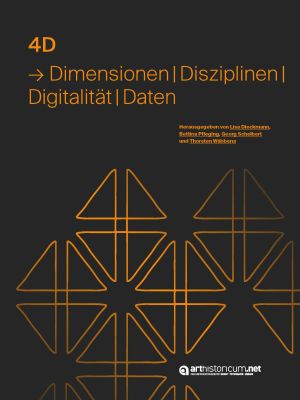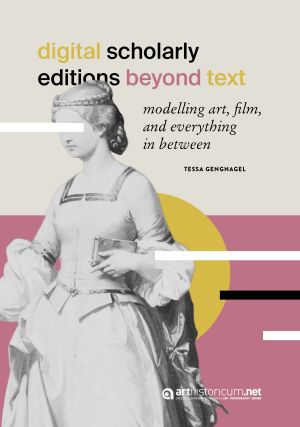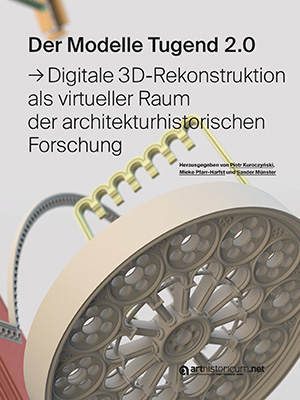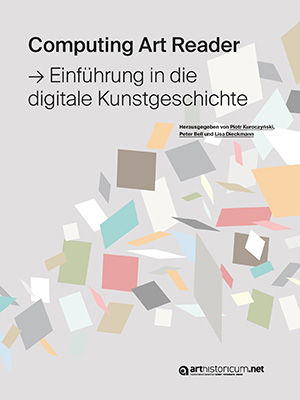Computing in Art and Architecture
The book series Computing in Art and Architecture is dedicated to the use and potential of digital research tools and to issues of a digitally oriented methodology and data culture in the object-related subjects of archaeology, architecture and art history.
As background serves the progressive development in the information and communication technologies in the sciences as well as the associated digital turn. It reveals previously unexpected opportunities in the humanities and at the same time confronts academic subjects with so far unknown technical and methodological challenges.
In particular, the object-oriented disciplines such as archaeology, architecture and art history recognize the great potential of a networked work environment, of the semantic modeling of research data, of an analysis and evaluation of contextualized data sets as well as of the novel simulation and visualization of research results. At the same time, many essential issues of a digitally oriented methodology and new data culture have to remain unanswered for the time being. The same applies to fundamental questions of the future scientific documentation and traceability of results, of licensing and copyright, of long-term archiving and of the availability of knowledge.
Against this background, the Working Group Digital Art History, was founded in 2012. It regards itself as an association that represents art historical topics, in particular in the field of German digital humanities. In 2014, the working group was expanded by the foundation of the Working Group Digital Reconstruction as part of the Association for Digital Humanities in the German-speaking Areas, registered association, which aims to provide a platform for the closer exchange and establishment of scientific tools and methodologies of digital 3-D reconstruction within the digital humanities.
With the book series, the results of these thematic fields will be gathered for publication. The volumes of the series deal with the use of digital techniques and procedures in the scientific examination of object-related themes in the humanities. The focus lies on the computer as tool, on its possibilities and limits as well as on a methodological application of computing to teaching, research and knowledge transfer.
Editors
Prof. Dr.-Ing. Piotr Kuroczyński (editor-in-chief), Institute of Architecture, Hochschule Mainz – University of Applied Sciences
Prof. Dr. Peter Bell, Institute of Art History, Kunstgeschichtliches Institut, Philipps-Universität Marburg
Dr. Lisa Dieckmann, Institute of Art History at Cologne University
Prof. Dr. Stephan Hoppe, Institute of Art History, Ludwig-Maximilian-University Munich
Jun.-Prof. Dr. Sander Münster, Digital Humanities, Friedrich-Schiller-Universität Jena
Coming Soon
Published so far
4D: Dimensionen | Disziplinen | Digitalität | Daten
20 years ago, prometheus was launched as a distributed digital image archive for art history and image-based disciplines, marking a fundamental step for the digital transformation in the respective subjects. Since then, the contours of a future digitally supported science have become clearer. The Digital Humanities are expanding the methodological field of the humanities, interdisciplinary collaboration to answer research questions is increasingly gaining acceptance, and the establishment of a National Research Data Infrastructure is laying the foundations for a science system in transition.
The 2021 anniversary conference discussed the transformation of the sciences under four perspectives (4D) and deliberately went beyond the subject boundaries of art history.
In this publication, the contributions appear successively. They are edited, have the final layout and are included unchanged in the full volume. Each early-view article receives a persistent DOI and is thus fully citable; only no pages can be given yet. Only when all articles are available will they be given page numbers. Please use the citation recommendation given in the PDF for the Early View. In addition to the e-book (PDF), a print edition will also be published.
Digital Scholarly Editions Beyond Text: Modelling Art, Film, and Everything in Between
Scholarly editions contextualize our cultural heritage. Traditionally, methodologies from the field of scholarly editing are applied to works of literature, e.g. in order to trace their genesis or present their varied history of transmission. What do we make of the variance in other types of cultural heritage? How can we describe, record, and reproduce it systematically? From medieval to modern times, from image to audiovisual media, the book traces discourses across different disciplines in order to develop a conceptual model for scholarly editions on a broader scale. By doing so, it also delves into the theory and philosophy of the (digital) humanities as such.
Digitale Raumdarstellung: Barocke Deckenmalerei und Virtual Reality
Baroque ceiling painting as architecture-bound painting can be documented and explored in digital representations. Data-driven digital representations are a fairly new medium that has only just developed its specific aesthetic qualities, but in many areas has long since found its way into everyday life. Digital reconstructions of stately interiors are already frequently found in castles and museums. This volume provides a comprehensive insight into techniques and practices of digital reconstruction from the perspective of the corpus of Baroque ceiling painting in Germany and discusses current and future challenges in this field of research. In addition to practical approaches, it offers reflective and theoretical approaches to the subject. With the help of digital representations of space, new, previously rather marginal research questions can be answered. For research, research communication, mediation and citizen science, there are still untapped possibilities that are repeatedly raised in the volume. Instead of a general overview, the volume offers a concrete, research-led and art historical approach to the topic of virtual reality.
Digitale 3D-Modelle historischer Architektur: Entwicklung, Potentiale und Analyse eines neuen Bildmediums aus kunsthistorischer Perspektive
Digital 3D models of historical architecture ➔ Development, potentials and analysis of a new visual medium from an art historical perspective for the first time offers a comprehensive historical overview of the genesis of digital architectural reconstructions from an art historical perspective. The central aim of the book is to show the potential of this new visual medium and research tool in the humanities and cultural sciences by means of an art-historical analysis of digital 3D models. Essential discourses, desiderata and needs for action in the areas of hypothesis visualization, documentation of the reconstruction process and long-term archiving are discussed. The book offers the scientific community a sound basis for locating digital 3D models of historical architecture in the context of possible research questions, essential needs for action and for initiating impulses for future projects.
Der Modelle Tugend 2.0: Digitale 3D-Rekonstruktion als virtueller Raum der architekturhistorischen Forschung
The Model Virtue 2.0 - Digital 3D-reconstruction as a virtual space of architectural-historical research understands digital 3D-reconstruction as part of interdisciplinary object-based research. In the guise of a manual, comprehensive methodologies at the interface between archaeology, art and architectural history and computer graphics and cultural informatics are presented and discussed. The central aim of the book is to illustrate the width of the current scientific debate focused on digital 3D reconstructions and to present previous traditions and developments, the current state of research and practice as well as future challenges and desiderata. Students, scientists and interested laypersons will receive a profound overview of the topic of digital 3D reconstruction in the field of architectural history. The work also offers the specialist community a solid basis and thus the point of departure for the identification of future fields of action and suggestions for further debate.
Computing Art Reader: Einführung in die digitale Kunstgeschichte
Der Arbeitskreis Digitale Kunstgeschichte versteht sich als Netzwerk, das digitale Methoden im Fach Kunstgeschichte stärkt und gleichsam bildwissenschaftliche Forschung weitreichender in den Digital Humanities etabliert. Dazu richtet sich das Engagement des Arbeitskreises und seiner Mitglieder nicht nur auf die Weiterentwicklung digitaler Infrastrukturen und Werkzeuge, sondern auch auf die methodenkritische Vermittlung vielfältiger Ansätze digitaler Kunstgeschichte in der Lehre.
Der Computing Art Reader — Einführung in die digitale Kunstgeschichte stellt einen Schritt zur Umsetzung dieser Aufgaben dar. Studierende und Lehrende der Kunstgeschichte und der Digital Humanities erhalten einen ersten Überblick über die verschiedenen Inhalte und Institutionen der digitalen Kunstgeschichte; festgehalten durch einige der Akteurinnen und Akteure selbst. Die Texte bilden ein Mosaik aus theoretischen Essays, praxisnahen Projektbeschreibungen, Überblicken über Forschungszweige und kontroversen Positionstexten, in denen konkrete Technologien, aktuelle Diskurse und zukünftige Ziele des Teilgebiets ersichtlich werden.













